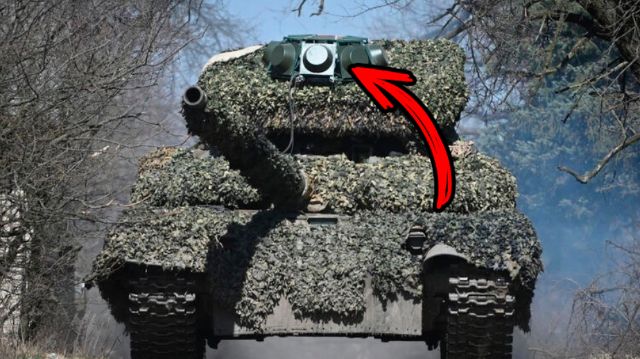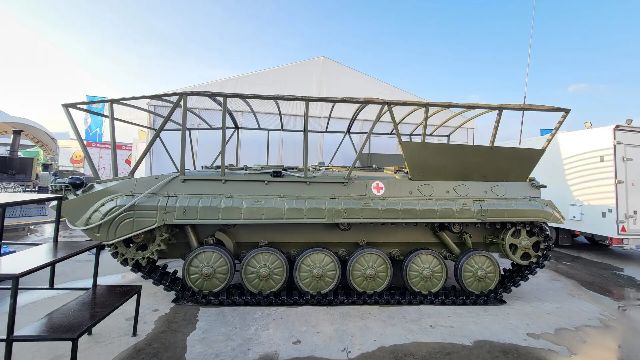𝙍𝙪𝙨𝙨𝙞𝙖𝙣 𝙏-72 𝙩𝙖𝙣𝙠 𝙖𝙙𝙤𝙥𝙩𝙨 𝙩𝙪𝙧𝙧𝙚𝙩 𝙀𝙒 𝙨𝙮𝙨𝙩𝙚𝙢 𝙩𝙤 𝙘𝙤𝙪𝙣𝙩𝙚𝙧 𝙁𝙋𝙑 𝙩𝙝𝙧𝙚𝙖𝙩𝙨
Images filtering out of Russia reveal a cleverly hidden T-72 tank. Intricate concealment efforts include a typical cope cage on the tank turret, which is also well-camouflaged. However, close inspection of the image discloses a device, mounting squarely on the tank turret. Russian insider conversations suggest that this could be an electronic warfare device.
 Photo credit: Dzen
Photo credit: Dzen
The complex camouflage makes it tough to accurately determine the model of the T-72 tank. Knowledgeable minds in Russia propose that it might predate the T-72BA model. This revamped beast isn’t confined to the training fields – it’s already carrying out its designated missions in Ukraine. It’s notable to mention, similar electronic warfare systems have been seen on local armored units, such as on the T-90M’s visor. As of now, the effectiveness of this new addition remains speculative. Gathering conclusive data on the ups and downs of this new system requires time and extensive deployment within the operational theatres.
Presently, Russia has encountered its first T-72 tank fitted with an integrated EW system. While there’s no direct information available about the exact model of this EW system, similarities with the Triton system are quite noticeable. Notably, the Triton system undertook tests in Russia on various tanks, mostly at interior tank test zones last year. If indeed this is the Triton, it seems the tests yielded successful results, potentially indicating its integration into certain Russian tanks for testing in actual combat situations.
 Photo credit: Dzen
Photo credit: Dzen
About Triton EW
The Triton drone defense system is made up of four emitters aligned to the corners of the tank’s turret anti-drone sight. Though the emitters are not visible in the provided photo, it’s worth mentioning that the crew of this T-72 has put great effort into fully and securely masking the T-72.
These emitters are designed to safeguard the tank from attacks from any direction by interrupting the primary frequency bands used in controlling UAVs. The protection scheme can be powered by either a battery or the tank’s integrated electric network, offering round-the-clock defense for the tank and crew from kamikaze drones.
 Photo credit: Telegram
Photo credit: Telegram
The core kit provides an option to block frequencies in four bands: 868, 915, 1200, and 2400 MHz. Either the vehicle’s internal power source or batteries can power this complex system, while operational control is provided through a remote device. It’s noteworthy that Triton has the flexibility to be installed on pickup trucks and ATVs, conveniently housed within a durable plastic case.
Russia uses Volnorez EW, too
Interestingly, when we look at the T-72 turret’s integrated system, it’s quite impressive in size, especially when compared to the electronic warfare [EW] system we observed last year on several tanks. This is the renowned Volnorez EW, which has been fitted on both manned combat vehicles and automated robots. Supporting this notion, documented last year, were pictures explicitly showing Volnorez EW mounted on a robot specifically used for transporting wounded soldiers from combat zones. This largely implies that over the past year, Russia has been diligently exploring various EW systems, in pursuit of identifying the most strategically effective one for use in combat operations.
 Photo credit: Defence Blog
Photo credit: Defence Blog
The primary purpose of Volnorez is to mitigate threats posed by unmanned aerial vehicles. It has been designed specifically for tank installations situated in conflict zones, particularly in the regions of Ukraine currently under occupation. BulgarianMilitary.com acknowledged in November that the Russian military had started receiving these electronic warfare systems, judging from the first photographic evidence that surfaced online.
Volnorez disrupts drone signals
The standout feature of the Volnorez system is its defensive prowess. It forms an impenetrable shield around the tank that leaves drones, including the kamikaze ones within the first-person-view [FPV] category, incapacitated. They become ineffective because of an inability to either send or receive commands within Volnorez’s defensive sphere.
 Photo credit: Telegram
Photo credit: Telegram
From what we know through Russian sources, the Volnorez system is designed to function across a frequency spectrum that ranges from 900 to 2000 MHz. This gives it the power to disrupt drone signals from a distance extending beyond 600 meters. This unique capability fortifies tanks against potential drone jamming. Add to that, the electronic warfare systems that these tanks are equipped with, which gives them all-round 360° coverage for absolute protection.
There’s one more aspect of the Volnorez system that deserves mention and that’s the convenience of remote control. This trait adds an element of versatility and adjustability that sets it up to effectively counter a variety of drone threats.
Tank threats
 Photo credit: Pinterest
Photo credit: Pinterest
For many decades, the ongoing tension between shell and armor has been the primary catalyst behind global tank manufacturing. Bigger calibers met their match in denser armor, concentrated shells were defeated by a unified hull and turret structure, subcaliber rods propelled the optimization of inclination angles for armor plates, and tandem warheads in anti-tank guided missiles [ATGMS] were countered with dynamic protection.
New decisions?
Today, however, a novel risk confronts tanks: precise, nearly invisible, extensive, and inexpensive. Regardless of the type of gun or projectile, it becomes irrelevant when a small FPV drone, with a PG-7V suspended under it, finds its way into the maintenance, repair, and operations [MRO] or the turret roof. The first can stop a vehicle in its tracks, while the others attack the weaker spots.
 Photo credit: MuxelAero / Twitter
Photo credit: MuxelAero / Twitter
Highly successful drone operations were somewhat deterred by the introduction of metal covers. Initially, they were only installed on turrets, but soon enough, crews began constructing protective grid shields even above the engine compartment. It goes without saying, that such structures decrease the tank’s efficiency by limiting turret rotation and visibility.
In the realm of digital warfare advancements, electronic warfare systems have emerged as the most effective and cutting-edge solution. Imagine a system that springs into action beforehand, neutralizing threats long before they come anywhere near your equipment. What happens to a drone controlled by an operator who suddenly finds themselves cut off due to radio-electronic warfare? Depending on its design, the drone either makes a landing or stays suspended in air until its battery depletes, due to signal loss. To bring it home, consider this – wouldn’t the T-72, the one caught on camera in Ukraine, serve as the perfect ‘prototype’ for an Electronic Warfare [EW] system designed to sort out the issue of pesky FPV drones?